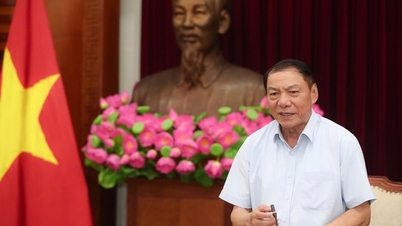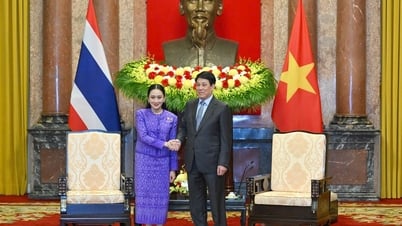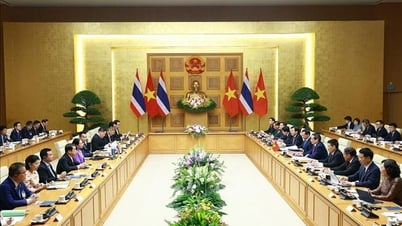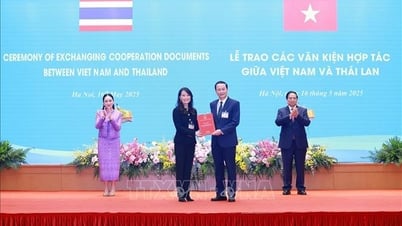Minister of Culture, Sports and Tourism Nguyen Van Hung gave an interview to VnExpress about solutions to promote Vietnam's cultural industry on the occasion of the Lunar New Year 2024.
- Looking back at 7 years of implementing the Strategy for developing Vietnam's cultural industries, which result are you most satisfied with?
- At the end of 2023, the Prime Minister will chair a national conference on the development of cultural industries to evaluate the implementation of the above strategy. From the conference, we can draw some typical highlights.
Firstly, the government, people and businesses are increasingly aware of the right position of cultural industries, so the index at the national level has achieved very positive results. The added value of cultural industries contributing to the economy in 2018 reached 5.82%; in 2019 reached 6.02%; in 2022, after 2 years 2020-2021 affected by the Covid-19 pandemic, the industries began to recover, with a contribution value of 4.04%. The production value of Vietnam's cultural industries in the period 2018-2022 contributed an average of 1,059 trillion VND (equivalent to about 44 billion USD).
The cultural industry is actively contributing to economic restructuring, job creation, and increasing people's income. In the period 2018-2022, the number of economic establishments operating in the cultural industry increased by 7.2% per year. In 2022, the country had more than 70,300 establishments with 2.3 million workers. In 2018, the cultural industry had a trade surplus of 37 billion USD, increasing to 41.9 billion USD in 2022.
Cultural industries also play an important role in integrating Vietnamese culture deeply into the world, promoting the image and identity, increasing the attractiveness and soft power of national culture. For example, Hanoi, Da Lat, and Hoi An joining the UNESCO Creative Cities Network are a solid foundation for Vietnam to determine its goal in the coming period to become a cultural industry center that attracts and converges creativity in Southeast Asia.
Vietnam has been honored as the world's leading heritage destination four times, demonstrating the outstanding global value and attractiveness of cultural tourism. Cultural industries have a higher value-added ratio than production costs, contributing to saving resources, promoting culture and national identity, meeting the goal of sustainable development. If we know how to exploit intellectual property, diverse culture, and rich identity, this will be an endless resource for the country.

Minister of Culture, Sports and Tourism Nguyen Van Hung. Photo: Nam Nguyen
- For many countries in the world, the cultural industry is an important part of the economy, bringing in significant foreign currency revenue through exports. In Vietnam, how is this issue approached, sir?
- At the international level, UNESCO has been discussing cultural industries since the late 1970s and early 1980s. Today, cultural industries and the creative economy are the driving force for sustainable development. The cultural sector accounts for 6.1% of the global economy with an annual turnover of up to 2,250 billion USD and nearly 30 million jobs.
In 2020, creative services exports brought in $206 billion to the US, $174 billion to Ireland, $75 billion to Germany, $59 billion to China, and $57 billion to the UK. China led the world in global creative goods exports in 2020 with $169 billion, followed by the US (32 billion), Italy (27 billion), and Germany (26 billion).
In Vietnam, culture has long been considered an ideological category, a spiritual foundation of society. Resolution 5 of the 8th Central Committee (1998) on building an advanced culture imbued with national identity for the first time mentioned economic policy and exploiting the economic potential of culture. Experts from the British Council and UNESCO were the first to introduce the content of cultural and creative industries in Vietnam.
During the years 2007-2014, many international conferences related to cultural industries were chaired by the Ministry of Culture, Sports and Tourism. However, it was not until 2014 that the Resolution of the 9th Central Conference of the 11th Party Congress officially included the phrase "cultural industry" in Party documents and determined to promote the development of cultural industries. Then, in 2016, the Prime Minister issued the Strategy for the Development of Vietnam's Cultural Industries to 2020, with a vision to 2030.
Since then, awareness of the role of cultural industries has been raised one step further. The first national conference on cultural industries recently was the driving force for these industries to take off.

Sweet Group takes a photo with thousands of audiences at the 2023 Monsoon Music Festival, October 2023. Photo: Organizing Committee
- Compared to the goal of cultural industry becoming an important economic sector contributing 7% to GDP, the current results are quite modest. What do you say about this?
- In addition to the initial results, we need to frankly recognize that Vietnam's cultural industry still has many limitations. Currently, there are no legal documents (laws, decrees) for state management of cultural industries. Specific and appropriate mechanisms and policies on attracting capital and developing resources to support and promote cultural industries are still lacking.
Investment resources are scattered, not focused on some majors with advantages and potential to create key products. Human resources in cultural industries are also lacking in quantity and quality because there are no incentive and attraction policies. Statistical indicators on cultural industries in the national statistical indicator system are not available, leading to untimely and unrealistic proposed solutions. The content and form of software products, handicrafts, design, architecture, fashion, etc. have not fully exploited the indigenous cultural characteristics to create uniqueness and competitive advantages.
The business sector has not really paid attention to protecting copyright and related rights, so violations and infringements in recent times have directly affected creators, hindering investment in this field.
Vietnam is a potential market with a young, open, and accessible population, but the habit and awareness of respecting, protecting, and developing cultural industrial products have not yet been formed. In addition, another reason is that although finance for the cultural industry has been raised, it is still low compared to demand.

My Tam's "Tri am" live show at My Dinh Stadium attracted 30,000 spectators, November 2022. Photo: Giang Huy
- What is the solution to promote Vietnam's cultural industry to take off?
- I think Vietnam has the opportunity to become the cultural industry center of Southeast Asia. To do this, we must first determine the goal of developing the cultural industry into an important economic sector, contributing 7% of GDP.
We need to build and develop diverse, high-quality cultural industrial products and services based on innovation, creativity, traditional culture, and respect for copyright. Product value needs to be enhanced to meet domestic and export demand. Vietnam needs to establish brands for cultural products and services.
Along with identifying key areas based on existing advantages to create regional and international competitiveness, Vietnam needs to soon form cultural industrial centers in Hanoi, Ho Chi Minh City, and Da Nang. The creative city network will expand to include Quang Ninh, Quang Nam, Kien Giang, Hue, Da Lat, etc.
In the coming time, we will study and complete the legal framework to open up the cultural industries, with preferential policies on capital, encouraging creativity and start-up businesses. Exchanges, joint ventures and partnerships with countries with developed cultural industries such as Korea, Japan, China... will be promoted.
Cultural industry statistics will also be added to the national statistical indicators system, in order to have appropriate investment policies and development roadmaps. Human resources need to focus on training through schools, links with businesses, and cooperation programs with international partners.
- Which areas will be prioritized for investment and development in the coming time?
- Vietnam's cultural industry consists of 12 sectors. We have a young, dynamic population that adapts quickly to world trends, so priority sectors need to take advantage of this, combined with cultural values and abundant creative materials.
First, the film industry will be prioritized. 2023 marks a strong growth in the commercial value of Vietnamese films with a revenue of 1,080 billion VND. This is the first record in the history of the box office. With the participation of investors and production units interested in traditional culture, many Vietnamese film projects aim to meet audience tastes and increase competitiveness. This is also a very effective way to promote Vietnamese culture to the world.
Vietnam has many traditional cultural values, contributing to building product brands associated with regions, so cultural tourism is also focused on. Performing arts will be our priority because Vietnam has many talented young artists who have been creating products with high revenue in the domestic market and reaching out to the world.
Vietnam's entertainment software and games in 2022 will reach a revenue of 148 billion USD, with a total workforce of 1.2 million people, making our country the second largest software exporter in the world. Vietnam's games revenue in 2022 will reach 665 million USD, ranking 5th in Southeast Asia and becoming the regional center for game programming and game software export.
In addition, the handicraft and design sector also needs to be prioritized for development. The handicraft industry in 2022 had a total export turnover of 4.4 billion USD, accounting for a significant proportion of the cultural industries. With a network of craft villages distributed widely throughout the country, this sector is playing an important role in developing the economy of each locality, preserving and promoting the cultural identity of Vietnamese craft villages.
The Vietnamese design industry has a lot of potential in terms of labor and market, so it has the momentum to develop strongly in the coming time. I hope that with its potential and advantages, the Vietnamese cultural industries will make an important contribution to the revival and development of the country's culture.
Source link



![[Photo] More than 17,000 candidates participate in the 2025 SPT Competency Assessment Test of Hanoi National University of Education](https://vphoto.vietnam.vn/thumb/1200x675/vietnam/resource/IMAGE/2025/5/17/e538d9a1636c407cbb211b314e6303fd)
![[Photo] Prime Minister Pham Minh Chinh chairs meeting on science and technology development](https://vphoto.vietnam.vn/thumb/1200x675/vietnam/resource/IMAGE/2025/5/17/ae80dd74c384439789b12013c738a045)
![[Photo] Readers line up to visit the photo exhibition and receive a special publication commemorating the 135th birthday of President Ho Chi Minh at Nhan Dan Newspaper](https://vphoto.vietnam.vn/thumb/1200x675/vietnam/resource/IMAGE/2025/5/17/85b3197fc6bd43e6a9ee4db15101005b)


































![[Photo] Nearly 3,000 students moved by stories about soldiers](https://vphoto.vietnam.vn/thumb/1200x675/vietnam/resource/IMAGE/2025/5/17/21da57c8241e42438b423eaa37215e0e)




































































Comment (0)